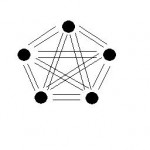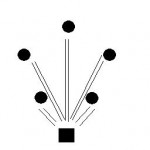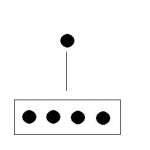Communication is vital in project management. In fact, I’d say good communication skills are one of the most important qualities a project manager can possess. But is a project manager getting involved in the internal communication of the project team actually providing value?
As a quick thought experiment, let’s imagine a team of five members. In a self-organising team, it may be that each member has a discussion with every other member to let them know where they are up to, what they are working on, etc. This communication, in one direction (i.e. person A telling person B their situation) takes an amount of time I’ll call t.
 Now, the communication cannot be one way – person B also needs to tell person A what they are up to. So they also take time t to pass that information on. So the total time for the update conversation is 2t. But the total work time is 4t – i.e. 2t for each participant.
Now, the communication cannot be one way – person B also needs to tell person A what they are up to. So they also take time t to pass that information on. So the total time for the update conversation is 2t. But the total work time is 4t – i.e. 2t for each participant.
I have shown this situation in the 5 person team in the diagram. In this situation, each person talks to every other person. There are 10 conversations, each taking a time of 2t. This means, with two people in each conversation, the total work time used is 40t.
 Now let’s look at the situation when we add a project manager. In this case, I have assumed each team member tells the project manager where they are up to. The project manager then evaluates the information, and feeds back to every team member. The two way conversation thus still exists, though the two ways may happen at different times. In this model, there are 5 conversations, each of which take time 2t, giving a total time of 10t, or a total work time of 20t.
Now let’s look at the situation when we add a project manager. In this case, I have assumed each team member tells the project manager where they are up to. The project manager then evaluates the information, and feeds back to every team member. The two way conversation thus still exists, though the two ways may happen at different times. In this model, there are 5 conversations, each of which take time 2t, giving a total time of 10t, or a total work time of 20t.
In other words, adding a project manager reduces the time the team spends in sharing information by half – in this particular case.
 Of course, there are other possibilities. It may be the self-organising team shares information through a meeting, rather than separate conversations. This would dramatically reduce the total time. In this model, person A tells all the other members of the team what they are doing at the same time. Then person B does so, and so on.
Of course, there are other possibilities. It may be the self-organising team shares information through a meeting, rather than separate conversations. This would dramatically reduce the total time. In this model, person A tells all the other members of the team what they are doing at the same time. Then person B does so, and so on.
This reduces the total time taken to just 5t, but the total work time is only reduced to 25t – it only takes person A time t to update the other 4, but each of the 5 has to be there, a total of 5t work time. This is repeated for the other 4 people.
In a team with a manager the total work time would be higher – purely because the project manager has to sit in the meeting too. If, however, the project manager receives updates from the team members individually (for a total work time of 10t) and then feeds back to the entire team (for a total work time of 6t) then we have a total work time of 16t – again less than in the self-organising team.
We can easily expand this up to teams with 10 members. In this case, team members holding individual conversations gives us a total work time used in communication of 180t, a team holding a meeting gives a total work time of 100t, while a team using a manager and meetings takes a total work time of 31t!
At this point it all looks cut and dried – self-organising teams, even if they use meetings, spend far more time in communication than a managed team.
Of course, that’s only true when you have been as grossly unfair with the figures as I have. (Using pseudo-scientific methods and information to draw unfounded conclusions is fun!)
The most obvious way I have been unfair is assuming the project manager can condense down everything all the team members need to know massively. In the model where the manager has a conversation with each team member, I have decided the information which the other team members took 4t to pass to him can somehow be condensed down to only take t for him to pass on! This seems rather unlikely…
So no, I’m not saying these figures are going to be accurate. But they do illustrate some important ideas.
- Time taken to communicate amongst a team rises dramatically with team size.
- The most effective way to reduce this is to hold meetings, so team members don’t have to repeat themselves with each other member.
- Project managers can aid communication if they act as a central collation point.
- But the best improvement in communication comes if the project manager condenses or filters the information.
In other words, you need to be more than good at talking. A project manager needs to understand the project well enough to know who needs to know which pieces of information, and just as importantly, which pieces of information are of no use to other members. You need to act as a filter, to make sure you’re not wasting the time of your team members.
Communication isn’t about how much you say to everyone, it’s about saying the right things to the right people.

 Now, the communication cannot be one way – person B also needs to tell person A what they are up to. So they also take time t to pass that information on. So the total time for the update conversation is 2t. But the total work time is 4t – i.e. 2t for each participant.
Now, the communication cannot be one way – person B also needs to tell person A what they are up to. So they also take time t to pass that information on. So the total time for the update conversation is 2t. But the total work time is 4t – i.e. 2t for each participant. Now let’s look at the situation when we add a project manager. In this case, I have assumed each team member tells the project manager where they are up to. The project manager then evaluates the information, and feeds back to every team member. The two way conversation thus still exists, though the two ways may happen at different times. In this model, there are 5 conversations, each of which take time 2t, giving a total time of 10t, or a total work time of 20t.
Now let’s look at the situation when we add a project manager. In this case, I have assumed each team member tells the project manager where they are up to. The project manager then evaluates the information, and feeds back to every team member. The two way conversation thus still exists, though the two ways may happen at different times. In this model, there are 5 conversations, each of which take time 2t, giving a total time of 10t, or a total work time of 20t. Of course, there are other possibilities. It may be the self-organising team shares information through a meeting, rather than separate conversations. This would dramatically reduce the total time. In this model, person A tells all the other members of the team what they are doing at the same time. Then person B does so, and so on.
Of course, there are other possibilities. It may be the self-organising team shares information through a meeting, rather than separate conversations. This would dramatically reduce the total time. In this model, person A tells all the other members of the team what they are doing at the same time. Then person B does so, and so on.